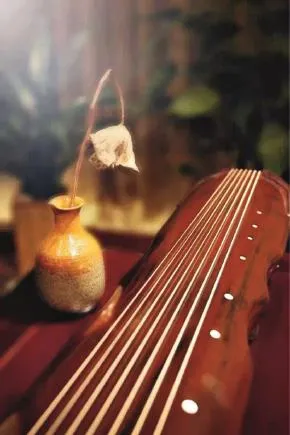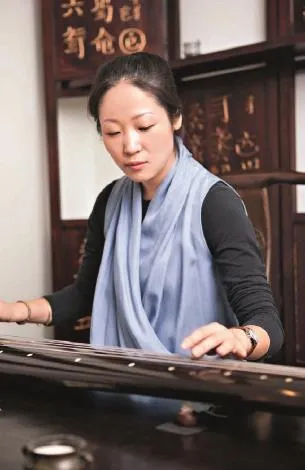The Guqin - Cultivator of Ancient Scholars
By ZHANG HUA
The Guqin - Cultivator of Ancient Scholars
By ZHANG HUA

The zither-like guqin.
IN earlier times, mastery of music,Chinese chess, calligraphy, and painting attested to a Chinese scholar’s level of cultural accomplishment.
Music came top of the list, and that played on the guqin, a zither-like instrument, was prominent in the lives of literary ancients. As early as the Western Zhou Dynasty (1046 - 771 BC) guqin playing was included in the “Six Arts” -the others those of ritual, archery, chariot racing, calligraphy, and computation. Instruction in music covered a broad range, within which the guqin occupied core status.
Exactly when the guqin came into existence is unclear, but we do know that there were virtuoso guqin players by the Western Zhou Dynasty. During the Spring and Autumn(770-476 BC)and Warring States (475-221 BC) periods the instrument was acclaimed to the extent of becoming an cultural icon. It was believed that guqin playing was a medium through which to cultivate moral character.
The guqin has appeared in several shapes, including the zhongni shape,named after Confucius, and the “banana leaf” shape. The earliest guqin had only five strings, each representing one of the Five Elements of earth and one of the five notes on the pentatonic scale as well. It was during the Han Dynasty(206 BC - AD 220) that two more strings were added, so making it a seven-string instrument.
When playing the guqin, the left hand presses the strings to produce the right note, while the thumb and first three fingers of the right hand pluck and strum them through various techniques. The manner of positioning the guqin, whereby the wider part of the instrument is on the right and overhangs the table, and the narrower section is on the left, is also codified.
The guqin has a range of four octaves and a major second. Its timbre can be altered through different fingering methods known as rebound, scattering, and overtone. Guqin music is mellow and elegant, recalling the decorum of past times. Ancient scholars regarded playing the instrument as a way of cultivating the character, which is why guqin playing has become synonymous with Chinese culture and virtue. Ji Kang (224-263) said in his Ode to the Qin: “The qin is only an instrument, but it embodies virtues.” The virtues it stands for are peacefulness and gentlemanliness.
Many guqin tunes, such as Lofty Mountains and Flowing Water, Eighteen Songs on a Nomad Flute, A Song of Guangling, and Parting at Yangguan Pass, are Chinese classics. Each piece tells of traditional values and their manifestation in ancient scholars. This unique instrument is thus imbued with the ethos of a Chinese gentleman in the Confucian sense.
Superior guqin are true masterpieces. In general, the body of the instrument is made from the Chinese Parasol tree. Craftsmanship in this regard reached its peak in the Tang Dynasty (618-907). Today, the quality of a guqin depends largely on the mastery of its maker,who is generally also an accomplished player.
Among the several guqin playing schools, those most distinguished are the Yushan, Guangling, Pucheng, and Yanshan schools.
The recent revival of traditional Chinese culture has reignited the guqin’s popularity and, as one of China’s cultural treasures, the guqin and its music were inscribed in 2008 on the UNESCO Representative List of the Intangible Cultural Heritage of Humanity. Whether or not certain innovations could make guqin music better meet modern social tastes is a question worth considering.

The Guqin is considered an important instrument for cultivating moral character.
(Selected from Monthly Digest by Zhonghua Book Company)

